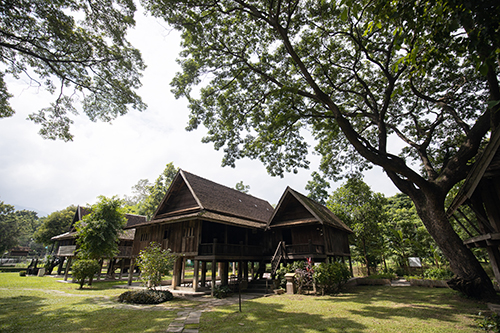
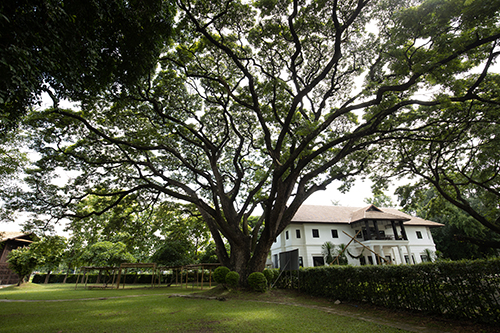
The peaceful setting of the CMU Lanna House Museum
Ten old wooden Lanna homes stand on nine rai of land under the shade of centuries-old raintrees, like an ancient village of yore, a living memory of traditions and times past.
The atmosphere invites a gentle stroll, as long as one observes some basic rules such as no running in the buildings, no smoking and no offensive behaviour which may not only insult the culture of the north, but potentially bring bad luck.
Each building is unique while the whole compound comes together as a museum filled with charm and beauty. Under the watchful eyes of the Centre for the Promotion of Arts and Culture, Chiang Mai University, an office dedicated to the preservation of Lanna arts and culture which also offers services to society by organising exhibitions and expertise to the public, the museum is not just a living testament to our shared past, but an educational tool for our future.
The Changing Times seen through the Cluster of Houses of the Lower Ping Basin
This unique real-life outdoors museum features over ten styles and eras of homes traditionally found in the Lower Ping Basin, each showcasing a unique architectural style representing a certain time and place. Details within each house reveal the minutiae of lives lived.
“What is truly fortunate about our open-air folk house museum is that it features authentic houses inhabited by real people,” explained Associate Professor Vilawan Svetsreni, Director of the Centre of Promotion of Arts and Culture, Chiang Mai University. “Others may have had to create a replica and display it in large buildings. We, however, are fortunate to have original houses relocated and rebuilt on this piece of land. They genuinely represent how people lived in the past – especially in the lower Ping basin which comprises Chiang Mai and Lamphun as well as surrounding areas. For example, a visit to the Heaun Phaya Pong Lang Ka, or Chiang Mai Townsfolk House, will bring you back to the year 1904. Then there is the Heuan Queripel, or Colonel House, built during the British-operated teak trading era with the Lanna Kingdom. What is most charming when strolling around is one can imagine how Lanna people lived in the olden days.”

Assistant Professor Vilawan Svetsreni, Director of the Centre for the Promotion of Arts and Culture, Chiang Mai University
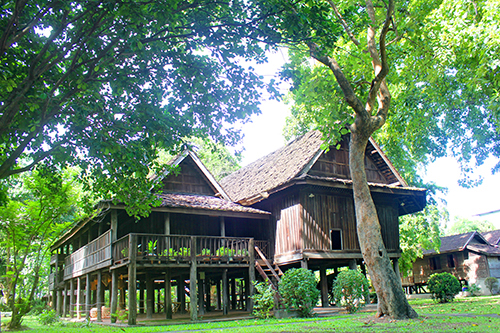
Heaun Tai-Lue (Mon Tood)

Mon Tood’s unique triangle gable which is exacting mathematically
Each house in the museum has a unique story. The first house we procured was a Tai-Lue house dating to 1917, and which used to belong to Tood Baisukhan (Mon Tood, or great-grandmother Tood). This simple wooden house represents a classic Tai-Lue style blended with Lanna structures, its highlight being the pediment (triangle gable) which is exacting mathematically and striking to the eye. It was moved to the museum from its original location at Ban Muang Luang, Luang Nuea Sub-district, Doi Saket District of Chiang Mai. In 1991 the late Ajarn Sirichai Narumitrekhakan, then-director of the university’s Social Research Institute bought this house with his own money, with some extra funding from the university, for the purpose of donating it to the university. In 1993 the house was moved to its current location, and the museum began its acquisitions in earnest.
As word of mouth spread that there was a museum to preserve old Lanna houses, home owners began to donate their houses to the museum, namely; Kruang-Puuk House (traditional Lanna/bamboo house), Heaun Phaya Pong Lang Ka, Kalae House (Heaun Phaya Wong), Kalae House (Heaun Oui Paad), Heaun Tai-Lue (Mon Tood), Northern Thai House (Heaun Oui Kaew), Mae Taeng Folk House, Pan-Ya Huse (Heaun Anusarn Sunthorn), Maenai Khamthieng’s ‘Fah Lai’ House and Colonial House (Heuan Queripel) which has stood in its current location since 1926. There are also four rice barns on premises – Heuan Kalae Phaya Wong (Laohawat), Long-Khao Saraphee, Long-Khao Pasang (Nandakwang Family) and Long-Khao Laohawat.
Heaun Phaya Pong Lang Ka was a house built in 1896, the year Chiang Mai celebrated its 600th anniversary and is a fine example of a house belonging to a wealthy person at the time. It has a generous ‘teon’ area to its front, a shady area where guests used to be received. This ‘teon’ is indicative of much of Lanna design in that it features a welcoming space, reflecting the warmth and generosity of its local culture and people. Another house which speaks to much more than mere architecture is Kalae House (Heaun Phaya Wong) which features a very interesting bedroom door frame decorated with fine ‘hum-yon’ wood carving, believed by locals at the time to prevent evil and bad luck from entering. In the past the owner of the home would use their foot measurement to design the hum-yon, another fascinating vignette from days gone by.

hum-yon
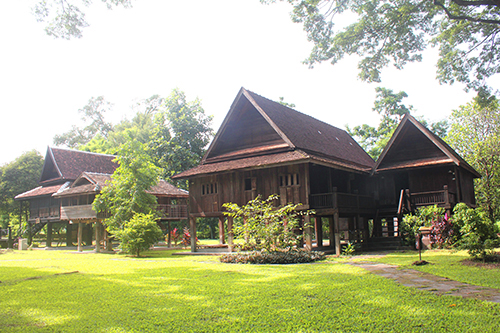
Heaun Phaya Pong Lan Ka
Heaun Phaya Pong Lan Ka’s ‘teon’ guest reception area
Travel Back in Time…A House with a Story
In the days when the British Bombay-Burma Company traded teak with the Lanna Kingdom, resulting in great riches flowing into the area, Arthur Lionel Queripel lived in this colonial style house which was built in 1926, where it stands today. While very different in style from all the other houses in the museum, this house is no less representative of the many faces of Lanna architecture through history.
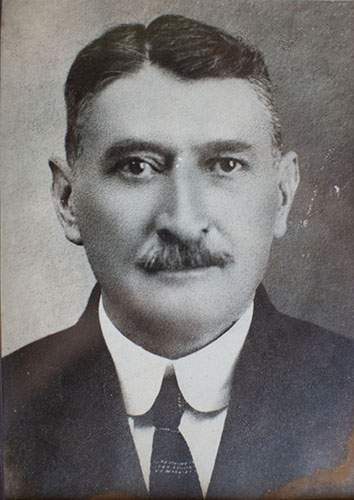
Mr. Arthur Lionel Queripel, owner of Heaun Queripel

Heaun Queripel
Sadly, when the second world war broke out Queripel, who was married to Dokchan, was ripped away from his happy home and taken away as a guest of the Thai government, after which he died. His family was forced to abandon the house, fleeing the war, only returning in 1963 when they lived temporarily in their home before it was repossessed and given to Chiang Mai University. The university eventually turned the house into the Social Research Institute, until the institute too was moved to a new location, leaving the building to become the Centre for the Promotion of Arts and Culture in 1994. Today visitors can experience, via digital projection mapping, the lifestyle and culture of the people during the colonial era, learn about the teak trading industry, the traditional clothes worn, colonial architecture and stories of the family that lived there. Modern technology has been harnessed to bring the past back to life in a vibrant and colourful way.
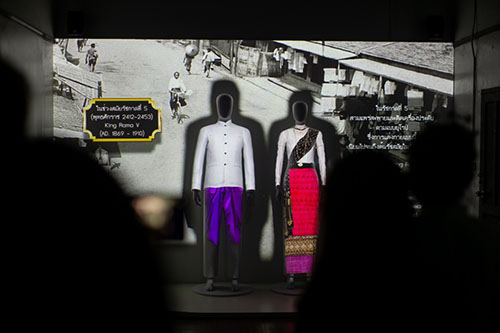
Digital projection mapping exhibition at Heaun Queripel
Another house with a fascinating story is Maenai Khamthieng’s ‘Fah Lai’ House which once stood on Wichayanon Road in the city of Chiang Mai. Built in 1914, this wooden two story house has a unique characteristic in its sliding walls which line all four sides of the house and provides excellent ventilation. Manually opened and closed, this is a rare example of this type of architecture. One side effect of such sliding walls is the shafts of sunlight which create patterns at different times of the day.
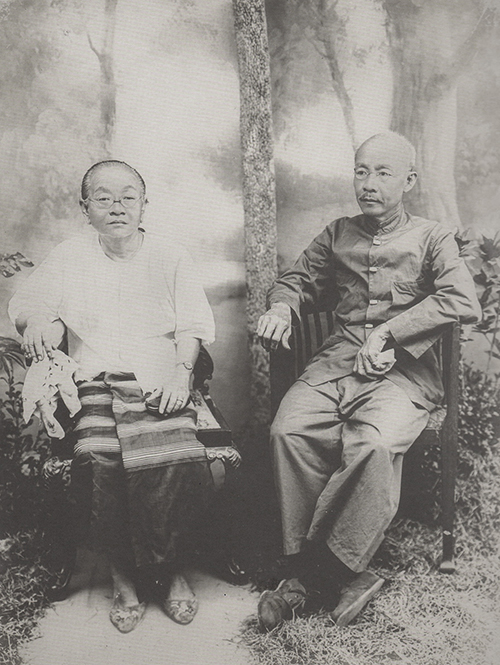
Luang Anusarn Sunthorn and Maenai Khamthieng Chutima
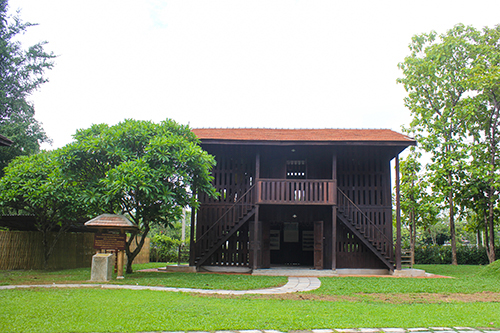
Maenai Khamthieng’s Heaun Fah Lai

Interior of Heaun Fah Lai
Maenai Khamthieng, who died in 1930, was the wife of Luang Anusarn Sunthorn, a wealthy patron who contributed greatly to many aspects of Chiang Mai. He died in the house in 1934, after which his relatives moved the house to the grounds of Suan Dok Temple, Wat Aram Luang to be used by the temple. In 2019 the temple had plans to construct a new building and subsequently donated Fah Lai House to the university to be preserved for future generations.
Chiang Mai University, Chumbhot-Pantip Foundation as well as the Anusarn group of companies donated funds for the deconstruction and reconstruction of the house.
When Love Happens in an Old Home
Through multiple annual events and other interactive participatory activities, the Chiang Mai University Lanna House Museum welcomes a great number of visitors each year. It is the aim of the Centre of Promotion of Arts and Culture to not only preserve Lanna culture and arts, but to interest the coming generations. Conversations about Lanna architecture and cultural activities There are also a number of events which attract the public interest such as the Aew Heaun Yeaun Phaya event, 2020’s short course on creative Lanna and craftsmanship and studies of Lanna lifestyle, etc.
Another area of work which the centre is focusing on is to organise field studies by visiting a multitude of communities where old houses are still standing, encouraging the local people and offering them expertise on how to turn their old houses into museums and attractions.
“We currently have ten houses and four rice granaries in our open-air museum,” explained Assistant Professor Vilawan. “They serve as a testament that it is possible to preserve part of our heritage this way. We hope to share our experiences and support various communities that wish to maintain their heritage as living museums, It could be started as an exemplar when visiting to see how we treat these houses as a living museum. Old houses need not be dismantled but could become a living museum within communities. A success in one community could serve as a case study for others to do the same. Descendants can then live in a house built by their ancestors, faithfully renovated, sustainably showcasing as art and cultural learning resources in their own communities.”
The quiet and simple power of conservation can be seen here at the Lanna House Museum, a place lovingly dedicated to the past with hopes of inspiring a future.